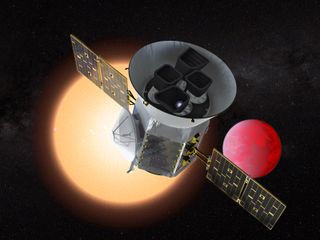
NASA's newest planet hunter will begin its search for alien worlds before the end of July, if everything goes according to plan.
The Transiting Exoplanet Survey Satellite (TESS), which launched to Earth orbit April 18 atop a SpaceX Falcon 9 rocket, is still undergoing commissioning tests, NASA officials said. But those checkouts should be done relatively soon.
"The TESS team has reported that the spacecraft and cameras are in good health, and the spacecraft has successfully reached its final science orbit," NASA officials wrote in an update Wednesday (July 11). "The team continues to conduct tests in order to optimize spacecraft performance, with a goal of beginning science at the end of July."
That start date would represent a delay of about six weeks; science operations were originally expected to begin in mid-June, NASA officials have said.
TESS' work will involve scrutinizing several hundred thousand stars in the sun's neighborhood, looking for tiny brightness dips caused by the passage of orbiting planets across the stars' faces.
NASA's famous Kepler space telescope has employed this same "transit method" to great effect, discovering about 70 percent of the 3,750 known exoplanets to date. But TESS could be even more prolific than Kepler when everything is said and done, TESS team members have said.
And, because TESS will study relatively nearby stars, it should find at least a few worlds whose atmospheres can be analyzed in depth by other instruments, including NASA's $8.8 billion James Webb Space Telescope, which is scheduled to launch in 2021. Such follow-up work could conceivably include the search for methane, oxygen and other gases that might be evidence of alien life.
Get the Space.com Newsletter
Breaking space news, the latest updates on rocket launches, skywatching events and more!
TESS' final science orbit is one that no other spacecraft has ever occupied. TESS is zooming around Earth on a highly elliptical, 13.7-day path that takes it as close to our planet as 67,000 miles (108,000 kilometers) and as far away as 232,000 miles (373,000 km). This orbit is very stable and subjects TESS to low radiation exposure and low thermal variation, mission team members have said.
TESS' primary mission is scheduled to last at least two years.
Follow Mike Wall on Twitter @michaeldwall and Google+. Follow us @Spacedotcom, Facebook or Google+. Originally published on Space.com.
Join our Space Forums to keep talking space on the latest missions, night sky and more! And if you have a news tip, correction or comment, let us know at: community@space.com.

Michael Wall is a Senior Space Writer with Space.com and joined the team in 2010. He primarily covers exoplanets, spaceflight and military space, but has been known to dabble in the space art beat. His book about the search for alien life, "Out There," was published on Nov. 13, 2018. Before becoming a science writer, Michael worked as a herpetologist and wildlife biologist. He has a Ph.D. in evolutionary biology from the University of Sydney, Australia, a bachelor's degree from the University of Arizona, and a graduate certificate in science writing from the University of California, Santa Cruz. To find out what his latest project is, you can follow Michael on Twitter.
